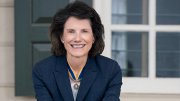The surveillance area of Harvard's network operations center (NOC) bears a fleeting resemblance to the helm of a starship. The large screen at center displays a schematic of Harvard's network nodes, each of which may represent individual computers or the network of an entire professional school. The command-center aesthetic is an apt one for NOC: its work has become increasingly important to the University, where daily operations, including Harvard's financial systems, have come to depend on the smooth functioning of an internal high-speed data network (HSDN).
As the year 2000 begins, the need for high performance links to remote networks is driving Harvard's participation in the Internet2 project--the next phase of Internet development--which promises a new generation of technologies and tools beyond familiar Internet applications such as e-mail and the World Wide Web.
Internet2 was started by a group of universities in 1996. More than 150 of the larger educational institutions in the United States now participate, along with a number of corporate members and affiliates. Myriad applications in the areas of scientific research, distance education, environmental monitoring, healthcare, and digital libraries are expected to require the broad bandwidths possible with this next generation Internet.
Harvard's connection to Internet2 is now in the process of being upgraded, says Leo Donnelly, senior technical consultant within University Information Systems. Redundant, 45-megabyte (MB) connections to the original Internet have been augmented with a 155 MB Internet2 connection. That connection runs to a GigaPoP, a high-performance aggregation point in downtown Boston, called Northern Crossroads (NoX), where network feeds from major educational institutions in the Northeast (including MIT, Tufts, Boston University, Northeastern, Dartmouth, and the Universities of Maine, Massachusetts, New Hampshire, and Vermont) come together in a facility owned by Internet2 corporate partner Qwest Communications. Harvard was chosen to manage NoX because of its well-engineered network operations center, maintained 24 hours a day, seven days a week.
The importance of a robust networking environment will only grow as the science initiatives announced by dean of the Faculty of Arts and Sciences Jeremy R. Knowles come to fruition (see "Big Thinking about Science," March-April 1999, page 65). Beyond enabling the work of the existing initiatives in genomics and imaging and mesoscale structures, Knowles has set as a goal the development of new search engines and other Internet tools. Internet2 will enable technologies like tele-immersion--remote immersion in virtual realities--to become practical. A promising application of such technology cited on the Internet2 website (www.internet2.edu) is a virtual laboratory project that would focus on the development of a nanomanipulator, "a natural virtual reality interface to network-connected scanning probe microscopes....Tele-immersion would go further by allowing several participants to share a common, realistically rendered virtual environment while communicating in normal human fashion within that virtual environment...."





